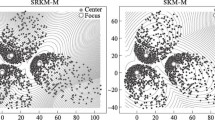Abstract
In this paper, we aim to develop an algorithm for the extraction of a medial set of a random point set in two-an d three-dimensional spaces. Using the medial set of a random point, we define the topology of a random point set. The algorithm for the extraction of a median set is based on the principal surface analysis.
Access this chapter
Tax calculation will be finalised at checkout
Purchases are for personal use only
Preview
Unable to display preview. Download preview PDF.
Similar content being viewed by others
References
Hasite, T., Stuetzle, T., Principal curves, J. Am. Statistical Assoc., 84, 502–516, 1989.
Kégl, B., Krzyzak, A., Linder, T., Zeger, K., Learning and design of principal curves, IEEE PAMI, 22, 281–297, 2000.
Oja, E., Principal components, minor components, and linear neural networks, Neural Networks, 5, 927–935, 1992.
Imiya, A., Ootani, H., PCA-based model selection and fitting for linear manifolds, LNAI, 2123, 278–292, 2001.
Imiya, A., Kawamoto, K., Learning dimensionality and orientations of 3D objects, Pattern Recognition Letters, 22, 75–83, 2001.
Blum, H., Biological shape and visual science, J. Theoretical Biology, 38, 205–285, 1963.
Rosenfeld, A., Axial representations of shapes, CVGIP, 33, 156–173, 1986.
Bookstein, F. L., The line-skeleton, CVGIP, 11, 1233–137, 1979
Amenta, N., Bern, M., Eppstein, D., The crust and the â-skeleton: Combinatorial curve reconstruction, Graphical Models and Image Processing, 60, 125–135, 1998.
Attali, D. and Montanvert, A., Computing and simplifying 2D and 3D continuous skeletons, CVIU, 67, 261–273, 1997.
Nystrom, I., Sanniti di Baja, G., Svensson, S., Curve skeletonization by junction detection Lecture Notes in Computer Science 2059, 229–238, 2001.
Svensson, S., Nystrom, I., Sanniti di Baja, G., Curve skeletonization of surfacelike objects in 3D images guided by voxel classification, Pattern Recognition Letters, 23, 1419–1426, 2002.
Sanniti di Baja, G., Svensson, S., Surface skeletons detected on the D6 distance transform. Lecture Notes in Computer Science 1876, 387–396, 2000.
Svensson, S., Borgefors, G., Nystrom, I., On reversible skeletonization using anchor-points from distance transforms Journal on Visual Communication and Image Representation 10, 379–397, 1999.
Svensson, S., Sanniti di Baja, G., Using distance transforms to decompose 3D discrete objects, Image and Vision Computing, 20, 529–540, 2002.
Silverman, B.W., Some aspects of the spline smoothing approach to nonparametric regression curve fitting, J.R. Statist. Soc, B. 47, 1–52, 1985.
Wahba, G., Surface fitting with scattered noisy data on Euclidean D-space and on the sphere, Rocky Mountain Journal of Mathematics, 14, 281–299, 1984.
Reed, M.K., Allen, A.K., 3-D modeling from range imagery, Image and Vision Computing, 17, 99–111, 1999.
Terzopoulos, D., The computation of visible-surface representations, IEEE PAMI, 10, 417–438, 1988.
Freedman, D., Efficient simplicial reconstruction of manifolds from their samples, IEEE PAMI, 24, 1349–1357, 2002.
Li, W. and Swetits, J. J., The linear l2 estimation and the Huber M-estimator, SIAM J. Optimization 8, 457–475, 1998.
Hoppe, H., DeRose, T., Duchamp, T., McDonald, J., Stuetzle, W., Surface reconstruction from unorganized points, “Computer Graphics (SIGGRAPH’ 92 Proceedings)”, 26, 71–78, 1992.
Taubin, G. Detecting and reconstructing subdivision connectivity, The Visual Computer, Vol18, 357–367, 2002.
Taubin, G., Ronfard, R., Implicit simplical models I: Adaptive curve reconstruction, PAMI, 18, 321–325, 1996.
Edelsbrunner, H., Shape reconstruction with Delaunay complex, Lecture Notes in Computer Science, 1380, 119–132, 1998.
Martinetz, T., and Schulten, K., Topology representing networks, Neural Networks, 7, 507–522, 1994.
Huisken, G., Flow by mean curvature of convex surface into sphere, Journal of Differential Geometry, 20, 237–266, 1984.
Bruckstein, A.M., Shapiro, G., and Shaked, D., Evolution of planar polygons, Journal of Pattern Recognition and Artificial Intelligence, 9, 991–1014, 1995.
Zhao, H.-K., Osher, S., Merriman, B., and Kang, M., Implicit and nonparametric shape reconstruction from unorganized points using variational level set method, CVIU, 80, 285–319, 2000.
Sethian, J. A., Level Set Methods: Evolving Interfaces in Geometry Fluid Mechanics, Computer Vision, and Material Science. Cambridge University Press, Cambridge, 1996.
Author information
Authors and Affiliations
Editor information
Editors and Affiliations
Rights and permissions
Copyright information
© 2003 Springer-Verlag Berlin Heidelberg
About this paper
Cite this paper
Imiya, A., Ootani, H., Tatara, K. (2003). Medial Set, Boundary, and Topology of Random Point Sets. In: Asano, T., Klette, R., Ronse, C. (eds) Geometry, Morphology, and Computational Imaging. Lecture Notes in Computer Science, vol 2616. Springer, Berlin, Heidelberg. https://doi.org/10.1007/3-540-36586-9_13
Download citation
DOI: https://doi.org/10.1007/3-540-36586-9_13
Published:
Publisher Name: Springer, Berlin, Heidelberg
Print ISBN: 978-3-540-00916-0
Online ISBN: 978-3-540-36586-0
eBook Packages: Springer Book Archive




